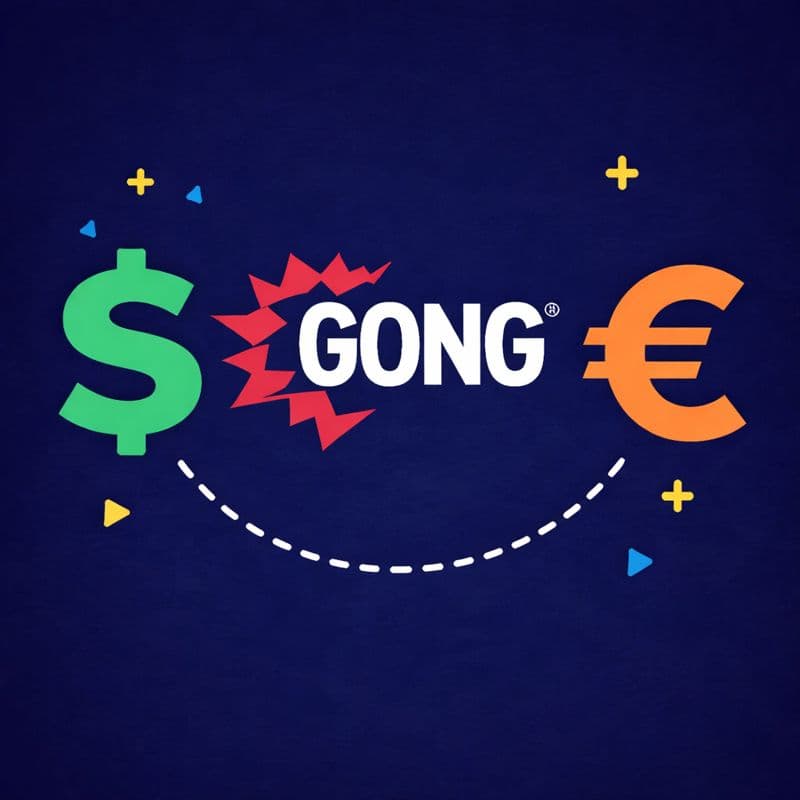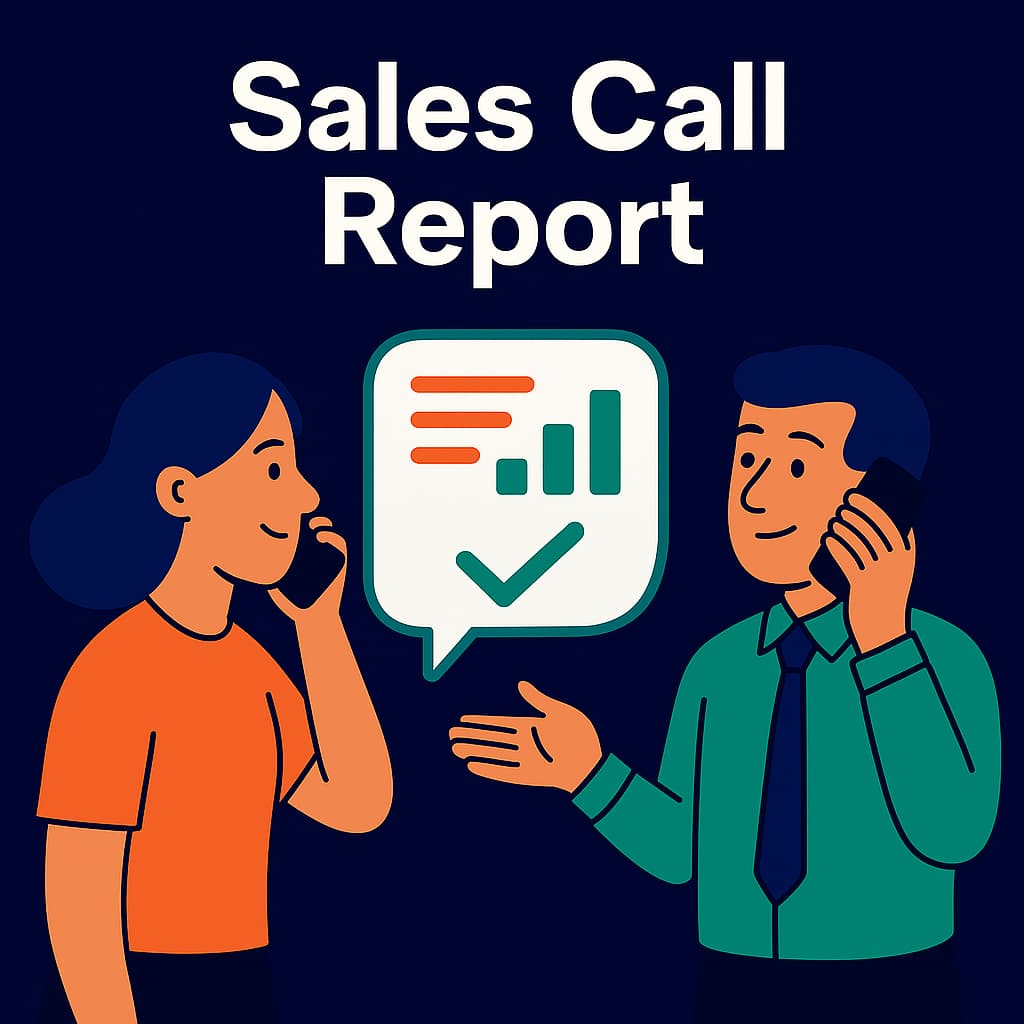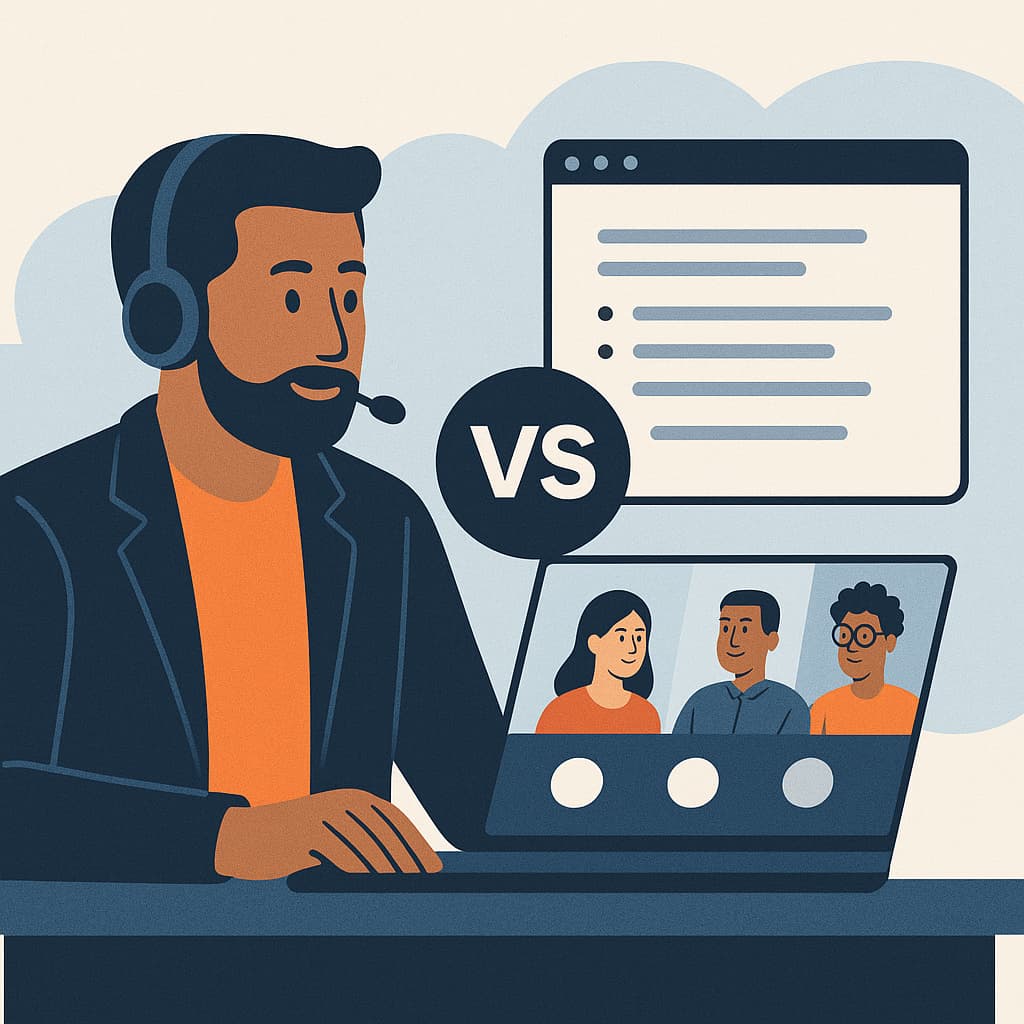Gong is a category-defining Revenue Intelligence platform—and one of the most expensive. Its AI-powered insights are impressive, but its pricing remains famously opaque, leaving teams unsure what they’re really signing up for.
This guide cuts through the noise.
We’ve analyzed real user quotes, pricing tiers, and deal data—so you don’t have to. You’ll also find a live pricing calculator, real-world TCO examples, and side-by-side comparisons with top Gong alternatives like Claap, Chorus, and Modjo.
👉 Whether you're planning your first rollout or renegotiating a renewal, this guide cuts through the clutter.
Gong Pricing Calculator: Estimate Your First-Year Cost
Trying to budget for Gong before entering a sales call? This calculator gives you a rough estimate based on your team size and expected usage.
Instructions: Choose your team size, platform tier, and onboarding scope to calculate your estimated first-year spend.
Use this Gong pricing calculator to estimate your first-year TCO based on real customer data.
📌 Disclaimer: This calculator provides an estimate for informational purposes only, based on publicly available data and user reports. Actual pricing may vary based on negotiation, business needs, and product mix. Platform and service fees are often negotiable.
Gong Pricing Breakdown – Platform + License + Add-ons
Gong's pricing is built on a three-part model: a flat annual platform fee, a per-user license cost, and mandatory professional services—typically for onboarding and implementation. While some discounts may apply at scale, most companies face a steep first-year bill.
Here’s a snapshot of estimated costs for 2025:
📌 Disclaimer: These estimates are based on user reports, market data, and competitor analyses. Gong’s pricing is quote-based and varies by team size, contract terms, and negotiation leverage.
What is Gong? A Quick Overview

Before we dive into the cost, here’s what Gong actually does.
Gong is a Revenue Intelligence platform designed to help B2B sales teams close more deals by analyzing customer interactions. It records, transcribes, and analyzes calls, emails, and meetings—turning everyday conversations into structured, searchable sales data.
At its core, Gong offers:
- Deal Intelligence – Visibility into pipeline risk and deal progression
- People Intelligence – Coaching insights to improve rep performance
- Market Intelligence – Trends and competitive signals extracted from conversations
Its primary value proposition: use AI to identify what top reps do differently, surface coaching opportunities, and deliver forecasting accuracy rooted in actual buyer conversations—not gut feel.
But these benefits come at a steep cost, especially for teams under 100 reps.
Gong Pricing Model Explained
Gong’s pricing doesn’t follow the familiar per-user SaaS model. Instead, it combines three distinct components—each carrying a substantial cost.
Component 1 – The Annual Platform Fee
This is the base cost every customer pays, regardless of team size. Think of it as the “entry ticket” to use Gong.
The platform fee covers:
- Platform access and admin console
- Unlimited data storage
- Native integrations (e.g. Salesforce)
- Standard support
Estimated Range: $5,000–$50,000 per year
Important: This fee is non-waivable for most teams and hits small teams hardest, since it doesn’t scale with user count.
Component 2 – Per-User Licensing Tiers
Each seat added to Gong incurs a separate annual license cost. This pricing is tiered based on volume:
Even with bulk discounts, many buyers report only marginal savings—and note that pricing discussions are often opaque or inconsistent across deals.
Component 3 – Mandatory Professional Services
Onboarding Gong isn't plug-and-play. Most teams are required to purchase a professional services package, which includes:
- Implementation support
- Admin training
- Technical setup (CRM integration, data mapping)
Estimated Range: $7,500–$28,500+
In some enterprise cases, onboarding fees have exceeded $30,000—especially with custom integrations or layered Gong products like Engage and Forecast.
These service costs can increase significantly if you require custom integrations or multi-product onboarding.
Gong’s Hidden Costs & Gotchas
Gong’s headline pricing is only part of the story. Many buyers discover additional costs and restrictive terms during procurement or renewal—often after internal budgets are already committed.
Here are the most common hidden costs and contractual pitfalls to watch for:
Multi-Year Contracts Are the Default
Gong typically requires a 2- to 3-year commitment, with annual payments due upfront. For mid-market and enterprise teams, this means locking in six-figure contracts with limited flexibility if priorities shift.
💬 One Reddit user shared:
“Our CFO had to push back hard just to get a 2-year term instead of 3—and that still required paying year one in full.”
No Monthly Plans
Gong does not offer monthly billing or short-term trials. Even smaller teams (under 25 seats) are expected to pay annual contracts in advance.
💬 From one G2 reviewer:
“We paid $9,500 upfront just for three seats—and still had to commit to a full year.”
Forced Bundling: Core + Engage = Double the Cost
If you’re interested in using Gong Engage (their prospecting and engagement product), you’ll also be required to license Gong Core for every user—even if you don’t need both.
This forced bundling often doubles your total per-user cost—without delivering twice the value.
🎯 This isn’t obvious until late in the sales process, when platform dependencies are revealed.
Renewal Price Uplifts
Unless specifically negotiated, Gong contracts include automatic renewal uplifts—meaning prices can increase significantly year over year.
📊 Best practice: Negotiate a price cap (3–5%) during your initial contract discussions and ensure it’s written into the renewal clause.
Downsizing Penalties
Most Gong contracts are not flexible if your team shrinks.
Whether due to layoffs, reorgs, or product pivots, you’re typically locked into the original seat count for the full term. Reducing licenses mid-contract often results in:
- No refunds or credits
- Inability to reallocate unused seats
- No downgrade path
⚠️ This inflexibility turns every seat into sunk cost when headcount changes.
Is Gong Worth It?
That depends—on your team size, budget, tech stack, and ability to drive adoption.
Gong delivers real value. But for many teams, the cost-to-impact ratio doesn’t hold up under scrutiny.
✅ What Are You Really Paying For with Gong?
Gong sells a powerful vision: record every sales call, analyze every deal, coach every rep. The platform promises sharper forecasting, stronger performance, and better pipeline visibility. And in many large orgs, it delivers.
But that value doesn’t come cheap — and it doesn’t always trickle down.
In this section, we look beyond the sticker price to ask a tougher question: Does Gong justify its cost, for teams like yours? Here's how the numbers—and real user experiences—break down.
1. High License Fees ≠ High Impact
Most teams expect a premium product to deliver premium results. But Gong’s platform fees, user licenses, and implementation costs can push first-year totals to $100K or more — even for mid-sized teams.
Yet some of those same teams struggle to drive usage beyond onboarding.
💬 “We planned for $100K. Ended up spending closer to $140K once we factored in services and team training.”
— Spendflo Case Study
💬 “Gong is very expensive… There are alternatives that do the job for a fraction of the price.”
— Claap Interview
2. It’s Powerful for Managers — But Often Ignored by Reps
Much of Gong’s value comes from dashboards, analytics, and coaching tools designed for managers and RevOps.
But what about the people actually making the calls?
Reps often see Gong as a burden: more admin, more tagging, more tracking. That low adoption rate undermines the ROI argument.
💬 “It felt like surveillance. Reps stopped tagging their meetings properly, and usage dropped after onboarding.”
— Reddit user
💬 “Our main persona is the salesperson who needs to save time after meetings. Gong doesn’t really serve them.”
— Reddit user
3. Your Data — But Their Lockbox
Recording calls is just the beginning. Many buyers assume they’ll be able to export, repurpose, or analyze their Gong data freely.
But in practice, Gong’s ecosystem can feel walled off. Export options are limited, API access is gated, and cross-functional sharing is a challenge.
💬 “We had four years of calls recorded in Gong and no idea how to extract insights. You’re locked into their UI.”
💬 “We had to redo our website, and I said, ‘Damn, we’ve got all this great content locked in Gong… but it’s impossible to activate this data.’”
4. Salesforce-First Design Can Undermine CRM ROI
Gong works best in Salesforce environments. If you run on HubSpot or a custom CRM, you may find key features missing — or broken altogether.
For HubSpot users especially, this often translates to manual workarounds, lost context, and poor CRM hygiene.
💬 “No native HubSpot integration. We had to manually push data to the CRM. A huge waste of time.”
— Trustpilot review
💬 “Gong has no real integration with HubSpot—especially for things like field population.”
5. Lack of Transparency Slows Time-to-Value
Gong doesn’t offer public pricing. You can’t test it without booking a demo. There’s no self-serve tier, no live sandbox, no quick setup.
That means teams often spend weeks in sales cycles just to validate basic fit — and even longer to implement.
💬 “We spent 3 weeks just trying to figure out if it was on budget. Meanwhile, Claap had a pricing page, a trial, and onboarding on day one.”
For fast-moving teams, that’s friction they can’t afford.
So... Is Gong Worth It?
If you’re running a large, complex sales org with deep RevOps maturity, Gong can pay off. The insights are real. The forecasting edge is measurable.
💬 “Once implemented, Gong helped us identify stalled deals faster and coach reps more consistently. Forecasting became far less subjective.”
— G2 Reviewer
But for leaner teams — especially those using HubSpot or operating on tighter budgets — the price-to-impact ratio starts to wobble.
When you’re spending five or six figures on a platform, you expect full adoption, seamless workflows, and actionable insights across the team. If Gong doesn’t deliver on all three? It might be time to rethink the investment.
Top 3 Affordable (and Powerful) Gong Alternatives for 2025
If Gong feels out of reach—or out of step with your team’s needs—you’re not alone. Dozens of tools now offer comparable features at a fraction of the cost, with faster implementation, better adoption, and simpler pricing.
Here’s how the top contenders stack up:
Master Comparison Table
📌 Note: Pricing is based on 2024–2025 public data, user reports, and competitive analysis. Always confirm with vendors directly.
Claap – Modern Revenue Intelligence: AI-Powered, Frictionless, Action-Ready.
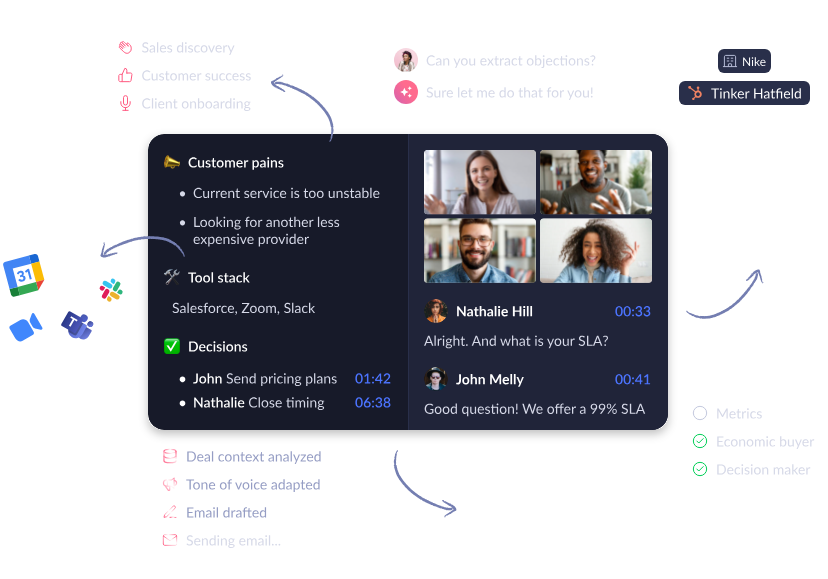
Claap isn’t just another conversation intelligence tool—it’s the modern, all-in-one workspace for sales teams who move fast. From AI note-taking to sales coaching and deep call & pipeline analytics, Claap gives reps and managers everything they need: more time, sharper insights to personalize every interaction, and higher conversion across the funnel.
- Transparent pricing & free trials — no platform fees, no hidden onboarding costs
- AI-powered summaries, highlights & action items in seconds
- Built-in automations for CRM sync, sales coaching workflows & reporting
- Intuitive UX = instant setup, faster ramp-up, broader adoption
- Advanced AI features & flexible customization out of the box
Best for: lean sales teams, startups & revenue leaders who want cutting-edge tech—without the enterprise bloat.
👉 Curious how we compare? Check out Claap vs Gong

Chorus.ai – Enterprise-Ready with Deep Integrations
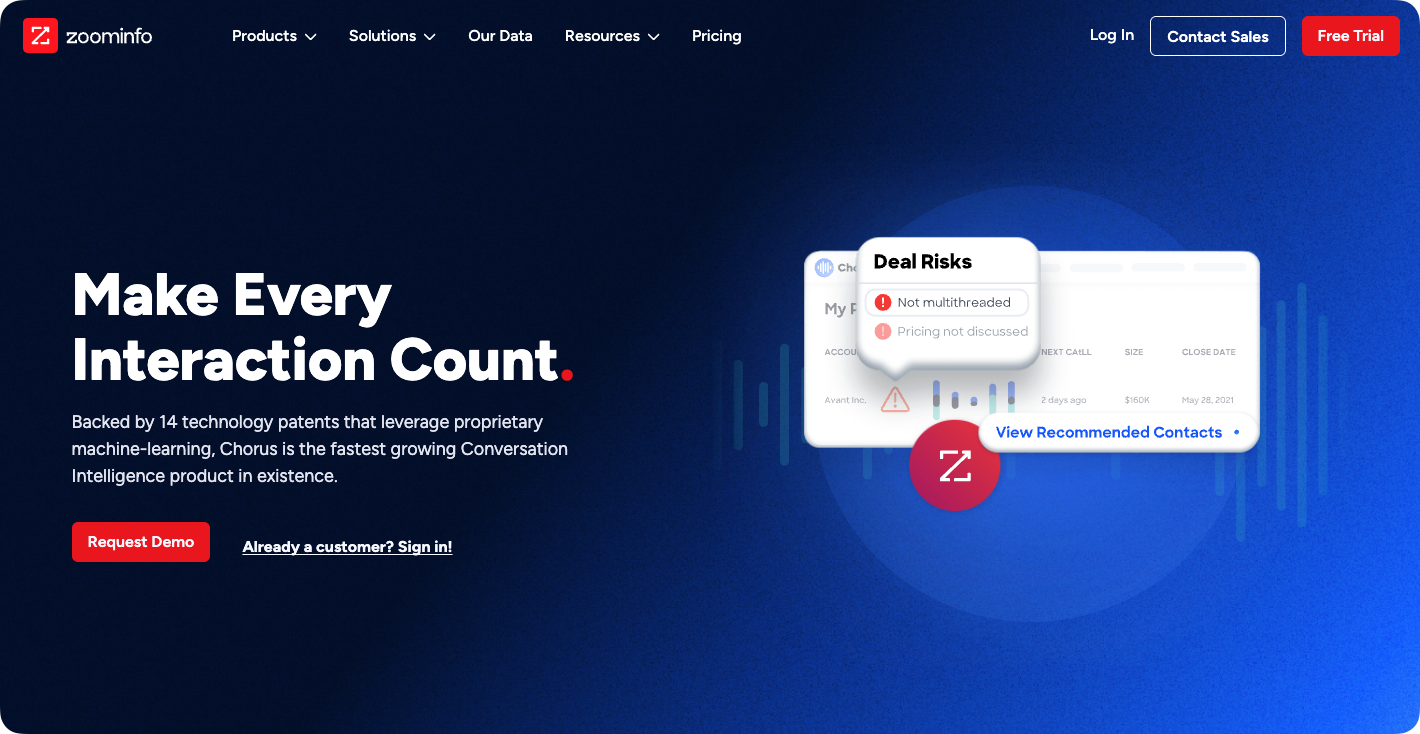
Now part of ZoomInfo, Chorus offers solid conversation intelligence with tight CRM sync and deep metadata tagging. It's best for teams already committed to the ZoomInfo ecosystem.
- Tiered pricing similar to Gong, but typically more flexible
- Strong call libraries and rep coaching tools
- Long implementation cycles and enterprise focus
Best for: large, data-heavy sales orgs with existing ZoomInfo investment.
👉 Curious how Chorus compare to Gong ? Check out Gong vs Chrorus
Modjo – EU-friendly sales coaching, but limited on AI
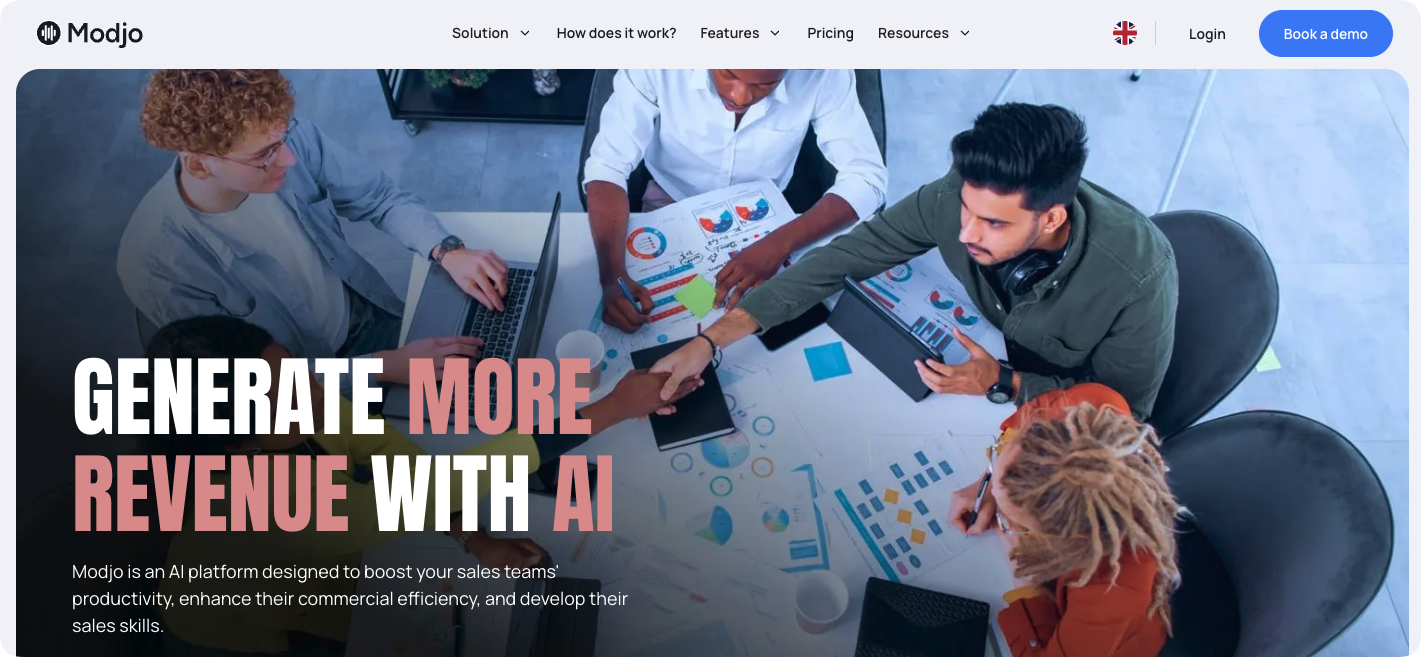
Modjo positions itself as a European alternative to Gong, focused on data compliance and simplicity. It covers the basics—like call recording, transcription, and deal coaching—without the complexity or cost of top-tier players.
- Lower per-user pricing than Gong
- GDPR-compliant storage for EU customers
- Limited integrations and automation features
Best for: mid-market European teams who prioritize local hosting over advanced AI.
👉 Check out Modjo alternatives here.
Fireflies.ai – Entry-Level Sales Call Analytics
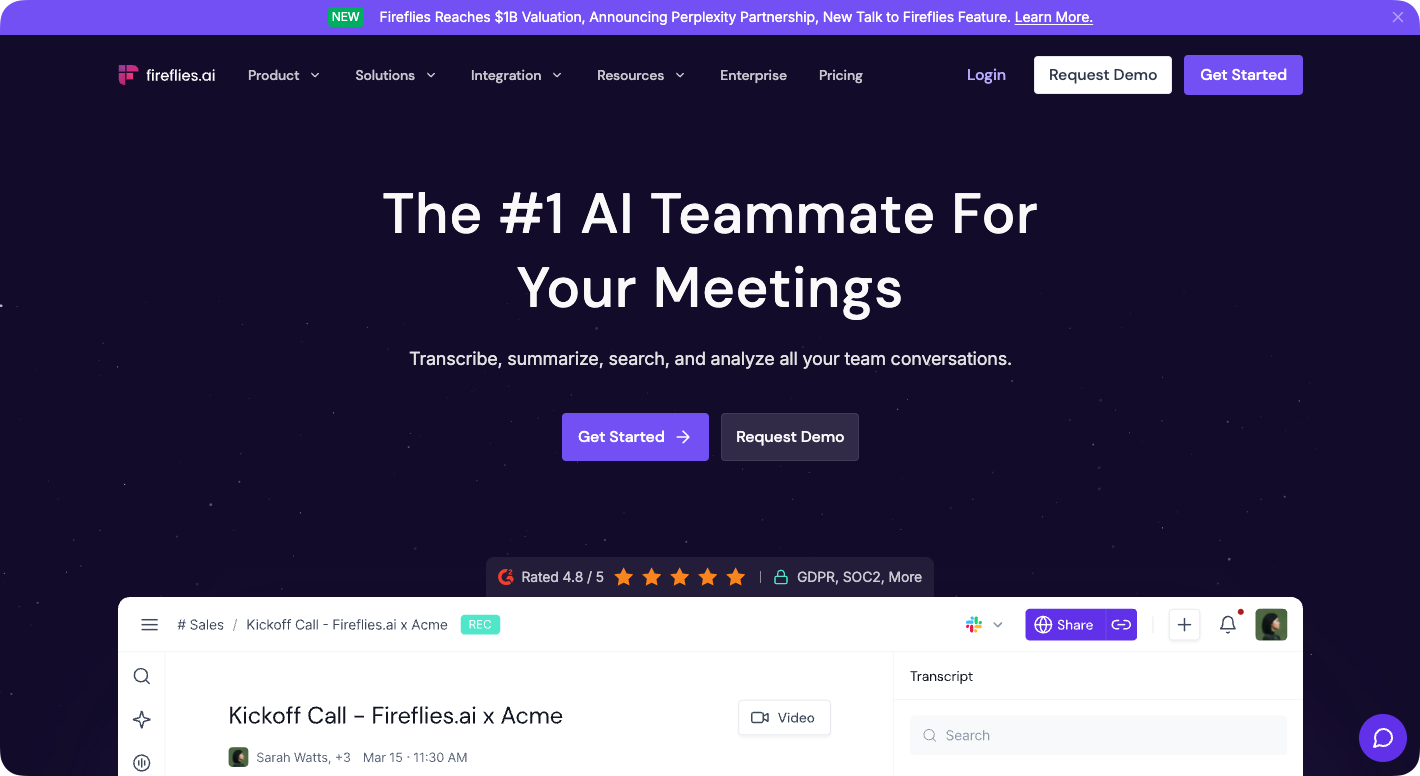
Fireflies is a lightweight conversation intelligence tool with a generous free plan, AI summaries, and calendar-based recording. It’s not as customizable or analytics-rich as Gong or Claap—but it’s hard to beat on simplicity and price.
- Free tier includes 800 minutes of transcription
- Chrome extension for 1-click call capture
- Missing CRM workflows, coaching tools, sales-specific insights, and advanced analytics.
Best for: Budget-conscious teams testing basic call analytics tools.
👉 Check out complete Fireflies.ai pricing here.
🤖 Can Gemini or ChatGPT Replace a Conversation Intelligence Tool?
Short answer: not yet — and not without serious duct tape.
While tools like ChatGPT or Gemini can transcribe and summarize meetings, they lack the sales-specific workflows, analytics, and integrations that define conversation intelligence software.
What they can do:
- Transcribe uploaded calls (with the right prompts)
- Generate summaries or action items
- Analyze tone or sentiment (in a generic way)
What they can’t do:
- Automatically record & log sales calls from Zoom/Meet
- Sync insights to CRMs like HubSpot or Salesforce
- Track deal progression or rep performance
- Support team-wide coaching and pipeline visibility
For solo founders or hobby projects, an LLM hack might get you partway there. But for scaling sales orgs, you’ll need real conversation intelligence infrastructure—not just a chatbot and a dream.
👉 Curious what a modern Conversation Intelligence tool can do? Book a demo here →
How to Beat Gong at the Pricing Game

If you’re set on Gong—or required to include it in your vendor shortlist—don’t go in blind. Gong's pricing is highly negotiable, especially for mid-market and enterprise deals.
According to CIO.com, buyers can often shave 20–30% off Gong's quote by pushing back on service tiers or requesting bundled pilots.
Gong doesn’t advertise pricing for a reason—but that doesn’t mean you can’t control the deal. Based on our analysis of 900+ real purchases, here’s how smart buyers are making savings by using real-world tactics.
Know the Benchmarks: Median Deal Value = $54,750
According to data from Vendr and community disclosures:
- Average Gong contract: $54,750 per year
- Average discount achieved: ~14%
- Top-tier discounts: 20–25% (with multi-year commitment)
💡Pro tip: If your quote is well above these numbers, you're likely being overcharged—or undersupported in negotiation.
Leverage Claap, Chorus, and Modjo in Your RFP
Nothing unlocks better pricing like credible competition. Many buyers report getting double-digit discounts by simply mentioning alternatives in discovery or proposal calls.
“Once we brought up Claap and Chorus, Gong dropped the platform fee from $15K to $7K.”
Name-drop with confidence—especially if you’ve tried other tools.
Push to Waive or Reduce the Platform Fee
This is the most negotiable component of Gong's pricing—especially for teams over 50 users. While listed at $5K–$50K, large teams have successfully reduced this to zero.
Tactics:
- Tie fee reduction to contract length or case study participation
- Use procurement or RevOps leads as pressure points
- Insist on ROI validation (e.g. pilot, adoption rates) before full activation
Offer a 2–3 Year Commitment In Exchange for Major Discounts
Gong rewards long-term deals—but you should get something in return.
Buyers have reported:
- 18–40% total savings when committing to 2–3 years upfront
- Waived onboarding fees or add-on modules included free
- Extended support or training layered in at no charge
📌 Make sure your headcount projections are conservative. You’ll likely be locked into your seat count for the full term.
Lock in a Renewal Cap (3–5% Max)
One of the most common traps: automatic price hikes on renewal. Some teams see 10–15% increases baked into default contracts.
Avoid this by:
- Asking for a 3% renewal cap, indexed to inflation or cost of living
- Writing the clause into the contract—not relying on verbal assurances
Time Your Purchase for End-of-Quarter Pressure
Gong reps—like most SaaS teams—work on aggressive quarterly quotas. End-of-quarter deals (March, June, September, December) give you maximum leverage.
“They told us they’d never go below $120K… but on June 28th, they dropped to $95K just to close.”
Bottom line: Gong doesn’t publish pricing because every price is up for grabs. With the right intel and timing, you can cut tens of thousands off your deal.
Claap delivers what Gong promises—without the platform tax. Try it for free.
FAQs
What is the Gong platform fee?
The platform fee is a mandatory annual charge starting around $5,000, scaling up with team size and complexity. It covers:
- Platform access
- Unlimited call storage
- Integrations and admin tools
This fee is highly negotiable—especially in larger deals.
How much does Gong cost for a small team (10 users)?
Expect to pay around $28,500 for your first year, broken down as follows:
- Platform fee: ~$5,000
- User licenses: ~$16,000 ($1,600/user)
- Onboarding & services: ~$7,500
📌 Note: Gong has a 3-seat minimum, and pricing is annual only—no monthly plans.
Does Gong offer a monthly plan?
No. Gong only sells annual or multi-year contracts. All payments are made upfront, with no monthly billing option available.
Can you get a discount on Gong?
Yes. Discounts of 5–25% are common—especially for:
- Larger user counts
- 2–3 year commitments
- Competitive vendor mentions
💡 The average discount across all buyers is ~14%, according to Vendr Marketplace - Gong.
Is Chorus.ai cheaper than Gong?
Generally, yes. While Chorus also charges a platform fee, its per-user costs tend to be 10–30% lower than Gong’s. The total savings depends on:
- Team size
- Contract term
- Whether you’re in the ZoomInfo ecosystem (Chorus is now part of it)
What are the best free alternatives to Gong?
No free tool matches Gong feature-for-feature, but Claap offers core functionality—like call recording, transcripts, sales coaching, sales AI agents, and pipeline analytics—at a fraction of the cost.
You can start with:
- Claap (free and paid tiers)
- Fireflies.ai
- Avoma (limited free version)
Why is Gong so expensive?
Gong’s pricing reflects its position as a market leader in revenue intelligence. You’re paying for:
- Advanced AI and forecasting
- Deep analytics
- Enterprise-grade infrastructure
- Full-service onboarding and support
But for smaller teams or fast-moving orgs, that feature depth may go unused or under-adopted—making the cost hard to justify.
Can I use ChatGPT or Gemini instead of Gong?
Not really. LLMs can transcribe and summarize—but they don’t replace true conversation intelligence tools.

